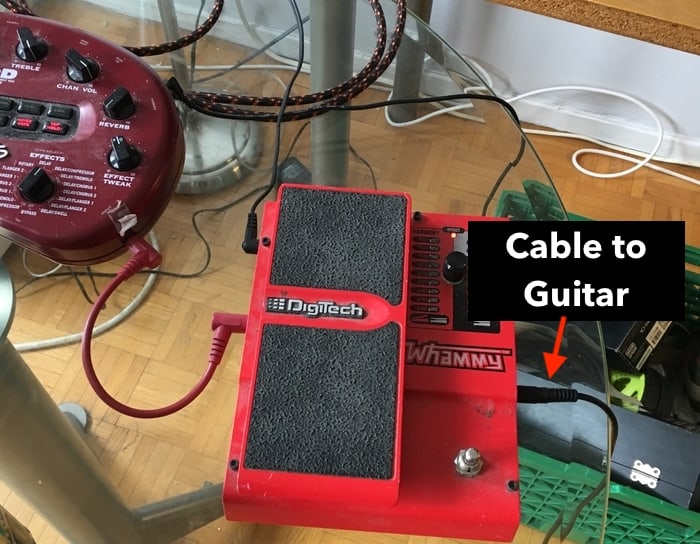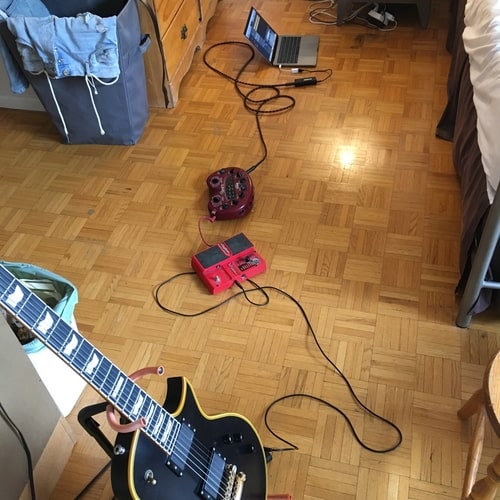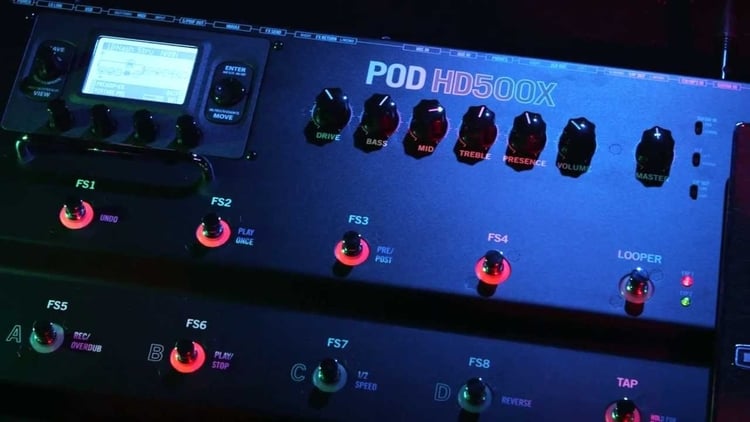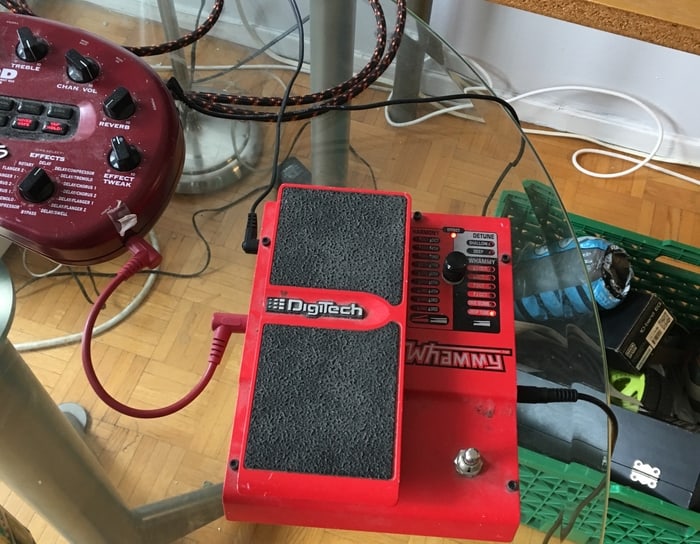Chances are if you’ve arrived at this article, you’re wondering if you can use Stomp Boxes, or guitar pedals, with Garageband, and the short answer is Yes – you can.
Before we get into the actual illustrated tutorial for how to do this, I’ll show you the basic steps.
To use guitar pedals in Garageband
1) Connect your audio interface to the computer
2) Set the Input/Output settings in Garageband’s Preferences to your audio interface and speakers
3) Connect the guitar pedal’s output to the audio interface’s input
4) Connect the guitar to the pedal’s input
If you want to use pieces of your old equipment for Garageband, know that you can definitely use them, whether it’s a Wah-Wah pedal, a Digitech Whammy Pedal, or an MXR-10 Band EQ pedal. In order to use your guitar pedals in Garageband, you need a couple of different pieces of equipment, which I’ve highlighted in the section below
Equipment You Need to Connect Guitar Pedals to Garageband
1) An Audio Interface like the Focusrite Scarlett 2i2.
I recommend either the Scarlett 2i2 or the iRig HD 2. Of course, there are other ones on the market, but I can only personally vouch for the iRig HD 2 and the 2i2. If you want portability, the iRig HD 2 is your best bet, but if you want overall quality and value, the Scarlett 2i2 is the way to go.
2) USB to USB-C Adaptor also on my Product Page
3) Guitar Cables (from the same place)
4) Your Guitar Pedal of course.
Personally, I’m actually using one of the old school Line 6 pod systems which came out over a decade ago (although, I’ve since started to use Blue Cat Audio’s Axiom). It still works and I love using it. I got it off of eBay a while back and it’s great.
From what I understand, Line 6 doesn’t make them anymore, however, they’ve since come out with other models that you could probably grab off of Amazon for a cheap price.
Frankly, there might be other ways of doing this, but this is how I learned to do it.
If you want to use your guitar pedals with Garageband, here’s what you do.
Connecting Guitar Pedals For Use In Your DAW
1) Connect your Audio Interface to your computer.
If you’re using a different interface, such as the Focusrite Saffire 2i2, keep in mind that the order of pedals is the same.

2) Connect the Guitar Pedal to your Audio Interface.
You want to use the output channel of the Interface, and then connect that to the output of the Guitar Pedal.

3) Then, connect your guitar to the Guitar Pedal’s input.

It really is as simple as that.
The beauty of this is that you can now use all of your old guitar pedals with Garageband, and there’s no limit to what you can do really, especially if you really understand how to use effects properly.
Truthfully, convenience and ease of use are probably the greatest aspects of using a DAW. For those reasons, I’ve pretty much abandoned my old Amp to Guitar combinations. I have a Hughes and Kettner Amplifier and a Mesa cabinet just sitting in my closet at home.
Amplifiers are just too heavy, bulky, and they take up way too much space. It’s a lot easier, and a lot better, to simply record everything through your computer and take advantage of the technology that has arisen in the last few years.
However, some would argue against this and say that the traditional analog is better, and while that may certainly be the case, the fact of the matter is that the new way of doing it is way less costly to attain and way easier to do.
How To Connect More Than One Guitar Pedal
If you want to connect more than one guitar pedal, you just do the same thing as you would with a guitar and amplifier combination. You interlink the guitar pedals with additional cables.
For instance, if I wanted to hook up my Whammy Pedal, I would hook it up to the Line 6 Pod system, so it’s just one channel removed from the guitar, this looks like the set-up you can see below:

For the sake of illustrating how this looks, in a clear line, I put my set up on the floor and took a picture so you can see the signal chain without the confusing and messy looking chords.

Common Practices For Basic Signal Chain
Similar to plug-ins, the order at which you place guitar pedals actually matters quite a bit. When it comes to making music in DAWs, from what I understand, the regular signal chain is usually as follows:
Dynamics > FX
For instance, you might start with the order of pedals as stated below:
Guitar > Compressor > Volume Pedal > Wah Pedal > Distortion > Chorus > Tremolo > Delay > Reverb > Audio Interface > and then your DAW.
***If I had to guess, I would say that with this many guitar pedals, there would likely be some kind of latency. I’ve never used this many pedals before, so I can’t say for sure, but I imagine latency is a possibility in this case (my guide on that).
The example above is meant more so to illustrate a common signal chain, rather than the perfect set-up for playing guitar in a DAW.
There are a number of different ways to go about the signal chain, so make sure to experiment.
If you’re anything like me, you’re not a big fan of experimenting and moving things like this around, and you’d rather just start creating music.
As a general rule, I just try and follow the rule of Dynamics first and then FX afterward.
In terms of what guitar pedals I would recommend, I would like you to check out the ones I’ve laid out at the beginning of the article and below.
1) Line 6 HD Pod500x

These pedals, despite what the haters may say, are incredibly awesome. They’re versatile and fun to use.
Moreover, they have so many settings and effects built in them that there’s really no reason to go out and get more effects pedals because these bad boys do the job.
2) Digitech Whammy Pedal

I wrote more about this pedal in a separate article and if you wanted to get your hands on it, you just have to go to Amazon to find it. This is the pedal that is commonly used by Tom Morello from Rage Against The Machine.
As I stated in my article linked above, you can detune your guitar with this and introduce dive-bombs and all kinds of stuff with it. It’s pretty cool. It even acts as a harmonizer pedal too.
3) MXR – 10 Band EQ

This is a nice little EQ pedal that can be used to get additional EQ frequencies on your set-up. This is very useful for getting the perfect tone. I’ve had this pedal now for about 7-8 years I believe.
Of course, you can also use the DAW to dial in effects as well, but this pedal kind of streamlines the process in my opinion.
Definitely worth checking out, moreover, you can use it for all kinds of instruments, as well as even vocals.
4) Boss RC-1 Loop Station

Looper pedals are great because they allow you to play something with your guitar, like a quick chord progression, and then you hit the button on the pedal and it plays it back to you for a pre-determined amount of time.
This is great for practicing improvisation as well as learning how to play modally which I’ve explored in other articles before.
I would highly recommend getting one of these looper pedals because they’re amazing for practice and also for creative purposes.
YouTube Video Tutorial
Conclusion
This is a bit of a short article, but I hope it was helpful for you.
Obviously, there are many other FX pedals that you can purchase, especially nowadays, when the stompbox market is booming like never before.
You can purchase many of these pedals on Amazon but also at your local music store.

 Written By :
Written By :